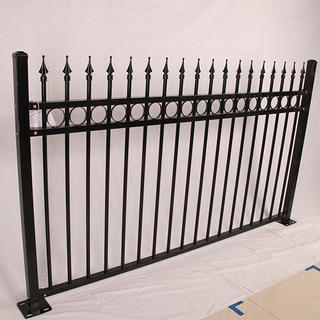Steel Fence is a robust and long-lasting barrier system crafted from high-quality steel, designed to provide security, durability, and aesthetic appeal for residential, commercial, and industrial properties. Known for its exceptional strength and resistance to impact, steel fencing offers superior protection against intruders and harsh weather conditions.
Available in various styles—such as ornamental, palisade, and tubular designs—steel fences combine functionality with visual elegance. Ornamental steel fences feature intricate patterns, often powder-coated in multiple colors to enhance curb appeal, while heavy-duty options like palisade fences are used in high-security areas. The material's inherent rigidity ensures minimal maintenance, with galvanized or powder-coated finishes providing additional corrosion resistance.
Ideal for perimeter security, pool enclosures, and decorative boundaries, steel fences are customizable in height and design to meet specific needs. Their modular construction allows for quick installation and adaptability to uneven terrain. With a lifespan far exceeding wood or vinyl alternatives, steel fences deliver unmatched reliability, making them a premium choice for property owners seeking both protection and sophistication.
Steel Fence for Schools and Public Institutions
Steel fencing is a top choice for schools and public institutions due to its strength, security, and low maintenance. The rigid construction deters unauthorized access while providing clear visibility for supervision—an essential feature for playgrounds, campuses, and government facilities. Steel fences can be designed with anti-climb features like narrow picket spacing or spear-topped rails to enhance safety. Custom heights (typically 6-8 feet) balance openness with perimeter control. Powder-coated or galvanized finishes allow color customization to match institutional branding while resisting graffiti and weathering. Unlike wrought iron, modern steel fences offer comparable elegance with lighter weight and easier installation. Gates can be fitted with access control systems for monitored entry points. The material’s longevity reduces replacement costs, and its non-combustible nature meets fire safety codes. For noise-sensitive areas like schools, solid steel panel variants help buffer sound. With proper coatings, steel fences withstand decades of heavy use in high-traffic public environments.
Powder Coated Steel Fence vs Galvanized – Which Is More Durable?
Powder-coated and galvanized steel fences offer different durability advantages. Galvanizing involves zinc coating (hot-dip or electroplated) that sacrificially protects the steel from rust, ideal for harsh climates or coastal areas. It requires no maintenance but offers limited color options. Powder coating applies a baked-on polymer layer that provides superior color retention and scratch resistance, preferred for aesthetic-driven projects like schools or parks. However, if chipped, underlying steel may corrode without proper primer layers. In extreme conditions, galvanizing generally outlasts powder coating, but combining both (galvanizing + powder coating) maximizes protection. For urban settings with moderate weather, powder-coated fences maintain appearance longer, while industrial or marine environments favor galvanized steel. Cost-wise, galvanizing is often cheaper initially, but powder coating reduces long-term repainting needs.
Does Steel Fence Rust? How to Prevent Corrosion Long Term
Steel fences can rust when exposed to moisture and oxygen, but proactive measures significantly extend their lifespan. Start with corrosion-resistant materials: hot-dip galvanized steel (zinc-coated) or stainless steel (chromium-nickel alloy) for high-humidity regions. Powder coating adds an extra barrier against water penetration, especially when applied over galvanized steel. Regular maintenance includes inspecting for chips or scratches—touch up damaged areas with zinc-rich paint to prevent oxidation spread. Ensure proper drainage around fence posts to avoid water pooling. In snowy climates, rinse off road salt periodically. Avoid direct ground contact by setting posts in concrete with waterproof sleeves. For coastal areas, choose marine-grade aluminum or 316 stainless steel fences. Applying annual wax or anti-corrosion sprays enhances protection. With these strategies, steel fences can remain rust-free for 20-30 years, even in challenging environments.


